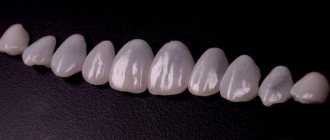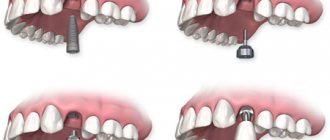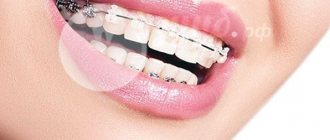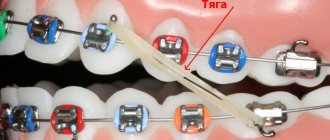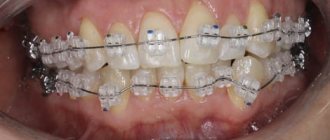Today there is absolutely no difficulty in correcting the position of teeth and making a beautiful smile. The pathology of crooked teeth and malocclusion can be present in both children and adults. Therefore, if you or your baby are directly faced with this problem, then going to the orthodontist will be the most correct solution. If you neglect this advice, then very soon problems with the gums, frequent formation of caries, and increased tooth wear may appear. This aesthetic condition of the teeth also negatively affects the psychological state of patients.
What types of veneers are there?
Depending on the material used, microprostheses can be:
- Ceramic
- Composite
Composite veneers are made directly in the patient’s mouth by layer-by-layer application of filling material to the tooth. They have a number of advantages: natural color, made in 1 visit, low cost compared to other methods. However, they are less durable and may change color or fade within 2-4 years.
Ceramic veneers are a porcelain plate no more than 0.5 mm thick. They are made from a custom impression of your teeth in a laboratory and then installed by your dentist. This smile will not fade, will look natural and will last you from 10 to 20 years. But installation of ceramic veneers requires 2-3 visits to the doctor and is more expensive.
In our Chelsena-Dent clinic we use German E-MAX veneers, which are made by pressing ceramic mass, which eliminates the occurrence of pores and defects.
Dental plate and braces will solve the problem of uneven teeth
Modern orthodontics has a large number of brace systems , which differ in price, quality, and type of fastening. Each type is established depending on the existing problem, as well as the financial capabilities of the patient.
Installation of braces in Minsk is one of the most common orthodontic services. Therefore, when coming to the Family Dentistry Center, many ask the question “Which braces to choose? Cost of construction? Now we will talk about this point in more detail.
When are veneers needed?
- Your teeth color has changed.
- There are gaps between the teeth - trema and diastema.
- Crowding and slight changes in the position of the teeth.
- Cracks and chips of the enamel appeared.
- Old restorations have changed color.
- Other whitening methods did not bring the desired effect.
Contraindications
- Presence of caries.
- Destruction of the tooth crown of more than ½ of its area.
- Periodontal disease.
- Bad habits (chewing a pencil, biting off a thread).
- Parafunctions of the masticatory muscles (“night grinding of teeth”).
- Poor oral hygiene
- Hobbies for extreme sports (boxing, cycling, jumping, hockey) increase the risk of the structure breaking off.
Difference between porcelain and composite veneers
The procedure for long-term installation of ultra-thin onlays on teeth made of pressed ceramics was developed only in the 80s of the last century, but since the 1930s, deficiencies have been corrected in a similar way using cementitious composites.
The most modern veneers are thin ceramic plates with a thickness of 0.3 mm made of lithium dioxide (E-Max Veneers), which are attached to the teeth with harmless glue, covering their visible part. This material has the highest strength with the smallest thickness. Using this alternative technology “IPS E Max Press Multi” (gradient glass ceramics), the cap of the desired shape and color is milled using CAD/CAM technology and is immediately monolithic and, accordingly, stronger. The technology cannot provide such a variety of colors as hand dyeing, but it compensates for this disadvantage with its strength (up to 400M) and durability.
Advantages
- They can withstand the heaviest loads - in some cases they can even be used on chewing teeth!
- Virtually impervious to staining.
- The thickness of 0.3 mm allows you to hide the edge of the veneer under the gum.
- The longest service life is 15-20 years!
- Retains original properties throughout the entire service life.
A classic and cheaper alternative is composite veneers, which are applied directly to the teeth in the form of a thick paste, similar in composition to a photopolymer filling (cement, plasticizers and proprietary nanomaterials of the manufacturer). Compounds from a good company can be polished perfectly, have an excellent shine and are much more resistant to wear and stress than their cheaper counterparts. And although, when comparing aesthetic and mechanical characteristics, such veneers are still inferior to ceramic ones, they can inexpensively eliminate all smile imperfections in just one visit to the dentist.
Sign up for a consultation
Stages of installing veneers
- An examination by a dentist will help you decide on the type of structure and identify possible contraindications. In the presence of caries and plaque, appropriate preparatory treatment is carried out.
- Enamel processing. When using a composite veneer, the tooth crown is ground to a thickness of up to 1 mm, while a ceramic veneer is ground to a thickness of 0.3-0.5 mm.
- An individual impression of the dentition is taken and sent to a dental laboratory.
- Making onlays in the laboratory.
- Installation of finished work. Bite correction.
- Training in care rules.
Types of braces and their prices
Installing braces is an affordable procedure that anyone can afford. Let's look at the approximate cost of braces in Minsk. Prices are indicated in Belarusian rubles after redenomination as of November 2016.
- Consultation with a specialist – 10 rubles. (without x-ray), 20 rub. (with x-ray);
- Metal braces, cost per jaw – from 600 rubles. up to 800 rubles. For two jaws you need to pay from 1200 to 1600 rubles;
- Aesthetic braces systems: one jaw – from 800 rubles, two – from 1600 to 1900 rubles;
- Self-regulating metal systems: 1 jaw – from 1000 to 1250 rubles, 2 jaws – from 1900 to 2400 rubles;
- Self-regulating brace systems (aesthetics plus metal): one jaw – from 1200 to 1400 rubles, two jaws – from 2200 to 3000 rubles;
- Lingual systems for one jaw from 7,000 rubles, for two – from 13,000 rubles;
- The upper jaw is aesthetic, the lower jaw is metal, the cost is from 1500 to 1800 rubles;
- Removal of the system - one jaw approximately 200 rubles;
- Mouth guard or plate from 150 rub.
Possible complications
- The veneers do not match the size and shape of the teeth.
- Deviation from the expected color.
- Premature detachment of the microprosthesis.
Complications occur extremely rarely and can be minimized only by wisely choosing a dental clinic and specialist. If you are looking for quality, not the lowest prices, you can count on excellent and long-lasting results.
Our dentistry "Chelsena-Dent" is proud of its specialists who have been giving their patients the smile of their dreams for 16 years. Don't wait for tomorrow, sign up for a consultation today!
Installation of veneers
Beautiful and straight teeth without flaws is the dream of many people, and veneers will really help you achieve this. The following facts about them will give you the necessary information about the features of their installation procedure. Veneers are not placed on chewing teeth, because... are not able to withstand the heavy chewing load that falls on them. Their area of application is only 10 upper and 8 lower teeth.
Before the actual installation, one of our therapists will carefully examine the condition of your teeth to make sure there are no caries, falling out fillings or loose teeth. Any of these reasons makes it impossible to install veneers without prior treatment.
When all obstacles have been removed, your orthopedist will remove a small layer of enamel from the visible part of the teeth, which will be replaced by your future snow-white caps.
Composite veneers can be installed in one or two visits. The entire procedure will take about two hours. After selecting the desired shade and applying it, the orthopedist will stabilize the composite with a special lamp and grind the onlays in accordance with your bite. Having eliminated the discomfort, he will carry out a final polishing of all surfaces.
Installation of orthopedic - ceramic veneers takes at least two visits after consultation. At the first stage, the dentist prepares the teeth and takes impressions. At the second stage, he will try on and fix microprostheses.
Video about installing veneers:
In this detailed video you will learn everything you need to know about veneers.
“Before and After” installation of veneers at Dudko and Sons dentistry
They will work with you
Balinda Vadim Stepanovich Specialist in the field of orthopedic dentistry. Proficient in all methods of removable and fixed prosthetics, including metal-ceramic structures and the use of supports on dental implants; aesthetic restoration of teeth using metal-free structures.
Shakun Anton Yurievich Specialist in the field of orthopedic and surgical dentistry. Proficient in all modern types of dental prosthetics and surgical treatment, including: • aesthetic restoration of teeth with metal-free structures; • prosthetics with metal-ceramic structures; • prosthetics on dental implants; • dental implantation.
Chelnokov Sergey Fedorovich Implantologist, work experience in private practice for more than 26 years. Able to successfully perform implantation regardless of the amount of bone tissue available to the patient and the condition of the bone. Participant of many congresses and seminars on implantation in Belarus and abroad. He is a lecturer at the Intrnatinal Implant Foundation (International Implant Society).
Attaching braces
Almost all types of brace systems are attached to the outside of the tooth, but there are products that are fixed from the inside (lingual braces). Their advantage is the deep correction of malocclusion, as well as the fact that they are practically invisible to people around them. After the specialist has installed braces, the patient will feel some discomfort for some time, which should soon go away. Diction can also be impaired within one month, this is due to the fact that the tongue gets used to the new oral cavity, because while wearing braces, the oral cavity becomes smaller.
By contacting the Family Dentistry Center, you can be sure that the installation procedure will be painless, high-quality and as quickly as possible. We hope that we were able to answer the question “How much do braces cost?”
Question answer
- Is it really necessary to quit smoking before implantation surgery and then not smoke for another six months? Smoking is a relative contraindication. Smoking is very harmful. If initially there are many risk factors, then we warn about this and the patient himself weighs the risk of smoking.
- Will implants interfere with general X-ray diagnostics of the body (and in particular the neck and head)?
The implants will not interfere with an X-ray examination.
How to preserve veneers for a long time?
After installing veneers, the most important rule is to wisely control the load on them. Be prepared to discard anything that could chip or peel records or crumble the composite. The recommendations below apply more to composite veneers, but even if you have installed E-Max, you should not open beer bottles or bite nuts with them!
- Don't bite!
Use a knife. Avoid biting off hard, fibrous foods with your front teeth. Be careful with meat, crackers, vegetables and fruits, and hard cookies. - Brush your teeth carefully!
Use a toothbrush, being careful not to damage the veneer with the hard part. If you suspect detachment, contact your dentist. - Forget about seeds!
At the very least, clean them by hand and chew them with your chewing teeth. - Avoid sudden changes in temperature!
It would be reckless to drink hot tea in the cold or wash down hot food with a cold drink. A sharp change in temperature can cause detachment or cracking of the microprosthesis. - Be careful with coloring products!
Composite veneers are somewhat susceptible to staining. With constant exposure, they can change their color, which will necessitate replacement.
